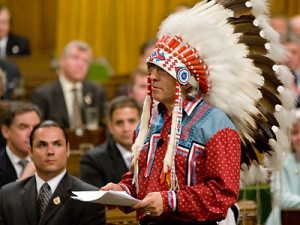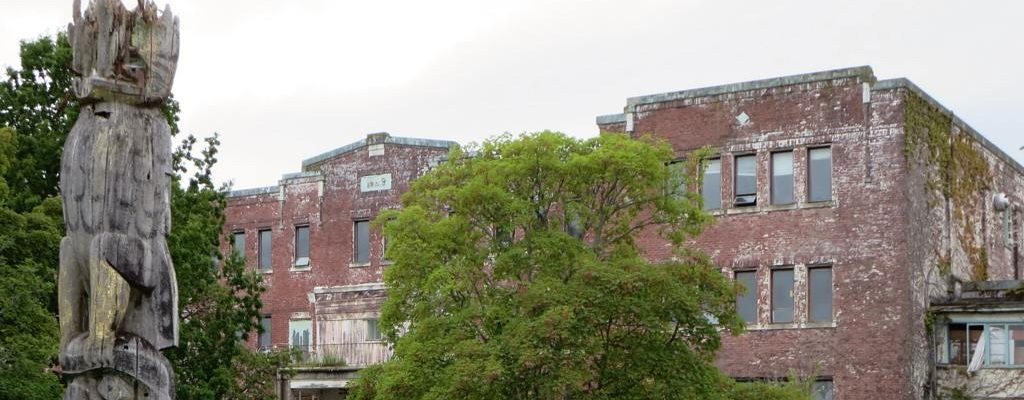Canada and her resident evil
In Canada, Kirsten-Rose Brooks was shocked by Indian Residental Schools
There is an episode in history that has been virtually ignored, that is destroying the lives of a significant group of people in a vicious cycle and is barely being addressed by the heirs of its perpetrators. It is dark, bloody and disturbing and the institutions concerned are only just starting to stumble towards acceptance and apology. Here I uncover the issue of the Indian Residential Schools, an instrument of British colonialism that began in the late nineteenth century and continued almost into the present one – the last school only closed in 1996. The ‘Indians’ I write about are the indigenous peoples of Canada, mainly First Nations people but also the Métis and Inuit populations, who live in greatly reduced numbers across Canada and still experience systematic racism as part of the legacy of colonialism.

» PM offers full apology on behalf of Canadians for the Indian Residential Schools system back in 2008 photo: Flickr/ pmwebphotos
This year I have swapped Warwick for the University of British Columbia in Vancouver, Canada. In between sightseeing and adjusting to the rigours of the North American university assessment system, I’ve been learning about the history of the province and have realised just how serious the problem of attitudes towards Aboriginal people in the country are.
At the beginning of any event, academic talk or even in the first classes of term, the speaker will acknowledge that UBC stands on the traditional, ancestral, unceded territory of the Musqueam people, viewed by some as an empty gesture but by others as necessary and respectful. The Truth and Reconciliation Commission (TRC), which opened in BC on September 18 this year, is leading a drive for awareness and education as well as addressing the repercussions of its colonial history. Just a few weeks into my year abroad, UBC cancelled a day’s classes – for the first time since World War Two! – so that students and staff could participate in the TRC and learn about its work.
I wouldn’t be surprised if you had no idea what the residential schools were or what their impact was (and is) on First Nation society: the majority of my Canadian classmates were, and most remain, equally unaware. From the late nineteenth century, the Canadian government and national Church followed an example set in the USA and set up a number of residential schools for Aboriginal children. They seized these children from their families and sent them to institutions in order to strip them of their heritage at an early age, to ‘kill the Indian in the child’. The children never fully learned their own language and were punished if they didn’t speak English, taught that their culture was inherently wrong and no longer relevant, and were often abused sexually, mentally, emotionally and physically. The abuse, poverty and alienation experienced by many pupils of the schools exists in a harsh cycle, passed down through generations. The parents, grandparents and authority figures of First Nations communities, especially in Western Canada, will all probably have attended the schools and the legacy of their experiences will take generations to heal.
This September and throughout the year in BC there are no shortage of opportunities to learn about the history and experiences of Aboriginal peoples in Canada. These include art exhibitions, film screenings, lectures and public events, many of them on campus. Even last week I attended the presentation of a paper on the representation of indigenous women in Canadian film and watched a disturbing short confronting the incursion of oil companies on native land. On the day off classes I caught a bus to the other side of Vancouver with some friends to attend the main TRC event at the Pacific National Exhibition, where there were panel sessions, talks and an atmosphere unlike anything else I’ve experienced. We visited the Sacred Fire, which is lit at every TRC event (currently held annually, each time in a different city) from the ashes of the previous fire, and watched as people walked up and prayed over the flames. It was intensely personal but fascinating to watch, and it was this combination that made me feel a little like a historical tourist, almost intrusive. It emphasised just how important the Commission was to many who were attending.
It’s difficult as an outsider to understand just how complex this issue is. I walked among the art and craft stalls admiring the symbols and elaborate jewellery, yet when I came to the tables offering support, guidance and information about the event I felt I had little right to pick up the pamphlets and copies of the official governmental apology, even though the historian’s burning for witness accounts and primary sources was racing within me. We were there to learn, yet I still felt there was a firm line in place, an understanding that we could respectfully acknowledge and celebrate indigenous culture, but not appropriate it or generalise it. This in itself was a different facet to ‘reconciliation’ and made for a powerful and thought-provoking experience. This presence of history and all its stories certainly weren’t what I expected when I applied for my year abroad in Canada, but now I’m fascinated by the ways in which such a history is being negotiated and approached.
In Britain, it seems that colonial history is skipped over or even glamourised. We may learn about slavery and exploitation but we are only scratching the surface – few of us realise that significant numbers of people are living today with the damaging effects of colonialism, of not only land seizure and displacement but concerted attempts at ridding settlements of indigenous peoples altogether, deliberately destroying their rich array of cultures. The news that the Canadian government is to formally reject a call from the UN to launch a national investigation into the sexual abuse, murder and disappearances of aboriginal women in the country is perhaps another indicator that serious problems will persist if direct action in support of First Nation peoples is not made a priority. The message of intercultural understanding was powerful. As young Aboriginals today are statistically more likely to go to jail than finish high school, the need for much better awareness has never been higher. ‘Truth’ and ‘reconciliation’ have endless meanings and implications for each person affected by the Indian Residential Schools, and while the TRC has made moves towards this, there is still a very long way to go to repair the damage done by colonialism.

Comments